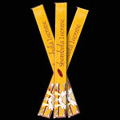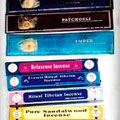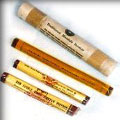
Perfumes, Aromatics, Toiletries, Ritual Arts/Crafts
Incense Craft of Nepal: Dhoop Rolls and Dhun Sticks
Hindus and Buddhists across the length and breadth of Nepal offer oblations and prayers to the gods and seek their blessings by burning incense. According to Nepalese religious traditions, there are five articles (panchopachar) that are essential in any act of religious worship: dhoop is one of the articles that is an essential part of the offering to the deity. In Nepal a large and varied variety of dhoop is available – it is believed that each one of these varieties possesses its own unique virtues, carries its own particular blessings, and has its own medicinal properties. Ancient manuscripts describe many varieties of dhoop. Special kinds of dhoops are said to possess the power of curing diseases, casting out evil spirits, invoking the nagas (deities) that control the rain-bearing clouds, and invoking Laxmi, the goddess of wealth and fortune.
PROCESS
A centuries old craft, dhoop-making is still commonly practised all over Nepal by women artisans and home based workers who utilise their leisure hours in twisting papers for the making of the dhoop. All the ingredients of the dhoop powder are readily available in the local markets or are sourced from nearby fields and forests.

Dhoop is made by rolling powdered herbal incenses into long paper strips. Thin sheets of locally produced Daphne bark (lokta) paper is cut into long strips, the length of the strips depending on the length of the requisite incense roll to be made. The dhoop roll can range from 5 to 6 inches in length to 2 to 3 feet. The longer dhoops naturally burn for a greater duration.
The basic process followed in making dhoops is similar, though many individual variations exist. The herbs to be used are first sun-dried; after all their moisture has been removed, they are pounded in a mortar. The mixture thus obtained is then sieved several times, resulting in a very fine powder. Next, paper strips of the required length are taken and the powder is uniformly spread in the middle of the paper strip. The paper strip is twisted into a thin roll, tightly encasing the powder, to create a dhoop roll.
MATERIALS & VARIETIES
Herbs and roots such as dhupi (Juniperus recurva), jatamasi (Nardostachys Jaramansi), the roots of the jasmine plant, kasturi or musk, anguru, manashila, gorochan, sandalwood, and red sandalwood (rakta chandan) are some of the ingredients of which dhoop is made.

- The most common dhoop, used in most worship is made from dhupi (Juniperus recurva), jatamashi (Nardostachys Jaramansi), and the roots of the jasmine plant.
- The pancha sugandha dhoop or five-fold incense is specially used for worshipping different deities. It is composed of equal parts of five (pancha = five) items: sandalwood, musk, kumkum, keshari, and anguru.
- The astagandha dhoop or eight-fold incense is burnt for invoking the deities on special occasions. This particular incense is supposed to bring peace and prosperity by driving away evil spirits. As its name suggests (asta = eight) it is composed of eight ingredients – sandalwood, red sandalwood or rakta chandan, saldhup, camphor, keshar, anguru, kasturi, and gungu. The ingredients are pulverised, mixed together, and made into incense rolls.
- The laxmi dhoop is believed to possessthe power to banish poverty and bring wealth and good luck to the family. The composition of this incense includes the addition of the laxmi flower and gungu to the pancha sugandha dhoop.
- The naga (or serpent) dhoop is based on the religious conviction that when this incense is burnt, the naga deity is invoked. As the nag is associated with rain, this incense is supposed to cause rain and remove drought. Whenever any stone fountain, well, or spring is constructed, this incense is burnt to invoke the naga.
- In Nepalese society, witchcraft is a belief that is still prevalent; the man who fights and drives away the witch is known as jhankri (i.e., a witch physician). If a person is troubled by a witch, a special kind of incense is burnt: this is called bokshi dhoop or the witch incense. It consists of upturned chillies, skin of snakes, and the (black) seeds of the lankashani plant (a plant with a white flower and black seeds). All the above ingredients are dried and powdered. When it is believed that a person is possessed by a witch, this incense is burnt; when burnt in the fire, the bokshi dhoop is supposed to releases forces that drive away the witch.
- Prolonged illness is attributed to the presence of an evil spirit haunting the house. In such cases, the sik vayu dhoop (ghost or spirit incense) is burnt; it is supposed to bring relief to the patient by driving away the evil spirit.

In Nepal the science of aromatherapy and the healing power of herbs is well known and utilised. However systematic research and documentation of this ancient knowledge and lore needs to be undertaken before it is lost.
DHUN STICKS
A variety of incense called dhun in Newari is made by the Tibetans. This does not require paper strips. The Tibetans collect specific fragrant herbs and pulverise them. They make the herb powders into pastes and smear the pastes uniformly on long sticks, which are then burnt during prayer.
Gallery
YOUR VIEWS
PRACTITIONERS: INDIA
Access 70,000+ practitioners in 2500+ crafts across India.
BIBLIOGRAPHY
10,000+ listings on arts, crafts, design, heritage, culture etc.
GLOSSARY
Rich and often unfamiliar vocabulary of crafts and textiles.
SHOP at India InCH
Needs to be written.





